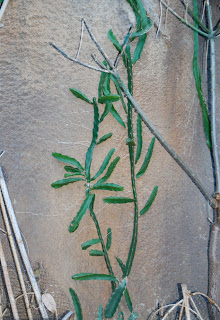
Origin : The exact origin is unknown and undated but the plant might come from an area situated between Mexico (Central America) and South America.
Area of Culture : Now, dragon fruit is widespread: it is cultivated around the world in tropical areas. You can find it mostly in Southeast Asia, Australia and South America.
Description : Pitahaya is a succulent and vining or creeping plant with green steems reaching from 6 to 12 feet long. The plant climbs onto trees using aerial roots. They propaged by seeds or by stem cuttings.
 Flowers are beautiful and some species are used as ornementals. They bloom only at night and one time. Flowers are called "Moonflower" or "Belle of the night". Blossoms are grouped together: 4 to 6 blossoms could succeed between December and April. These flowering cycles are leading to 4-6 fruiting cycles per year. As a consequence, you can find on the same plant at this period of time, buds, young fruits and mature fruits. Pollinisation is necessary to set fruit.
Flowers are beautiful and some species are used as ornementals. They bloom only at night and one time. Flowers are called "Moonflower" or "Belle of the night". Blossoms are grouped together: 4 to 6 blossoms could succeed between December and April. These flowering cycles are leading to 4-6 fruiting cycles per year. As a consequence, you can find on the same plant at this period of time, buds, young fruits and mature fruits. Pollinisation is necessary to set fruit.
Dragon fruits will be harvest around one month later pollinisation. They can weigh from 150-700g each. Some fruits reach 1kg.
They are three types of dragon fruits:

- Hylocereus undatus (Red Pitaya) with red skin and white flesh composed of a lot of small black seeds. The most commonly known as "Dragon fruit".
- Hylocereus costaricensis with red skin and red flesh composed also of a lot of small black seeds.
- Hylocereus megalanthus (Yellox Pitaya) with yellow skin and white flesh composed also of a lot of small black seeds.
Climatic conditions : Dragon fruit grows best in dry tropical areas with a moderate amount of rain. The annual rainfall may be situated between 600 to 1300 mm per year with an alternation of humid and dry seasons. The first summery rains begin blooming period. The plant tolerates high temperatures (38-40°C) and short period of frost otherwise the plant will be damage or kill.
 Cultural methods : Because of their epiphytic nature, plants are not much depending on soil types. It is recommended to grow them in soil that is supplemented with a high amount of organic materials. The plants also grow successfully in sandy soils. Attention needs to be paid to the plants because of their environment. A specie of ant Solenospsis germinata cause important damages to the plants and particularly to the fruits and steems. The bites caused seem to be a good entrance for other diseases for Pitaya. Birds can also be a nuisance for the plant. Overwatering or excessive rainfall can cause the flowers to simply drop off and rot. A specie of bacteria can also cause steems to rot.
Cultural methods : Because of their epiphytic nature, plants are not much depending on soil types. It is recommended to grow them in soil that is supplemented with a high amount of organic materials. The plants also grow successfully in sandy soils. Attention needs to be paid to the plants because of their environment. A specie of ant Solenospsis germinata cause important damages to the plants and particularly to the fruits and steems. The bites caused seem to be a good entrance for other diseases for Pitaya. Birds can also be a nuisance for the plant. Overwatering or excessive rainfall can cause the flowers to simply drop off and rot. A specie of bacteria can also cause steems to rot.
Uses : The only part of the fruit which is edible is the flesh: the skin is not eaten. It is recommended and very popular that dragon fruit is eaten chilled and alone to improve flavour. The fruit is low in calories. Eating fruit is likened to kiwi fruit. The fruit can be also converted into juice or used to flavour other drinks (tea..). Unopened flowerbuds are cooked and eaten as vegetables.



No comments:
Post a Comment